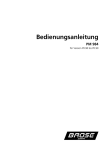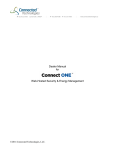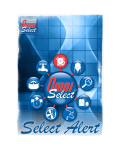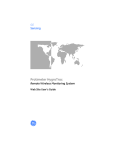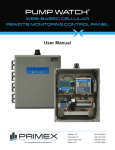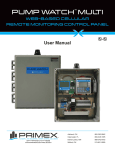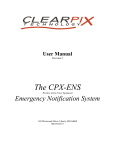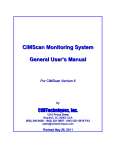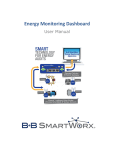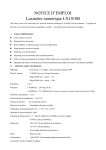Download User Manual - Amazon Web Services
Transcript
User Manual ©2015 Connected Technologies, LLC. Customer Overview .............................................................................................. 2 Application Overview ............................................................................................ 3 ScanPass® ............................................................................................................ 4 Monitor .................................................................................................................. 5 Activity - View Recent Events ............................................................................ 5 Arm/Disarm - View Alarm/Access Areas and Arm/Disarm ............................... 5 Zones & Sensors - View Zones and Bypass ..................................................... 6 Doors & Outputs - View Access Doors/Outputs and Lock/Unlock ..................... 6 Cameras - View Live Video ............................................................................... 6 HVAC - Control Thermostats............................................................................. 6 Lighting - Control Lighting ................................................................................. 6 Tasks - Activate Automation Tasks ................................................................... 6 Reporting .............................................................................................................. 7 Predefined Reports ........................................................................................... 7 Custom Reports ................................................................................................ 7 Users .................................................................................................................. 10 Profiles ................................................................................................................ 13 Login Profiles .................................................................................................. 13 System Profiles ............................................................................................... 16 Schedules ........................................................................................................... 17 Interaction ........................................................................................................... 19 Event Rules ..................................................................................................... 19 Time Rules ...................................................................................................... 22 Task Rules ...................................................................................................... 23 How to Setup an Event Rule for Notifications.................................................. 24 Utilities ................................................................................................................ 28 System Code Import Utility .............................................................................. 30 Appendix A: Event Type Descriptions ................................................................. 32 Appendix B: Live Video - IT Instructions ............................................................. 35 ©2015. Updated 12/15/2015 Page |1 Customer Overview Figure 1: Customer Hierarchy Structure The top-most level is the Customer. Below the customer are Sites, Systems and Devices. A site is referred to a postal address or single building. A system is a grouping of devices. The users under the customer may have access to any number of sites and systems configured. ©2015. Updated 12/15/2015 Page |2 Application Overview Connect ONE ESSENTIAL Allows access to view and control only - no management, notifications and any other PRO version features - Single User Login - Full Browser & Mobile Accessible Application Sections Monitor – View Real-Time Activity – Control Security & Energy Systems – View Live Video Connect ONE ESSENTIAL+ and PRO - Multi-User Login - Full Browser & Mobile Accessible Application Sections Monitor – View Real-Time Activity – Control Security & Energy Systems – View Live Video Reporting – Create Detailed Reports Users – Manage User Logins and System Codes Profiles – Manage Login Permissions and System Permissions Schedules – Manage Alarm, Access, & HVAC Setback Schedules Interaction – Event Rules (Notifications, HVAC Setbacks), Time Rules (Open/Close Windows) & Task Rules (Command Routines) Utilities – System Maintenance ©2015. Updated 12/15/2015 Page |3 ScanPass® ScanPass is a method of access control which allows your smartphone or other device to become your access credential thereby removing the necessity for card readers and cards. To use ScanPass you must have the appropriate control hardware onsite and have an enrolled ScanPass device code into the system, refer to the “Users” section of this manual. This will show the ScanPass button in the Connect ONE App for Apple iOS and Android devices. Simply press the ScanPass button to activate the camera mode on your device and hold it up to the barcode sticker on the door, center the barcode in the crosshairs. It is ideal to hold the device flat to the barcode and not at an angle. The camera mode will not timeout on the device/smartphone, so in situations where hands are full or environmental conditions exists, such as rain or snow, you may prepare the App and click on the ScanPass feature to start the camera mode prior to leaving your vehicle. This will also allow you to wear gloves without needing to press any buttons on your device once you arrive at the door. Example Uses: • Door Entry Access • Cabinet/Locker Access • Parking Gate Access • Codeless Arming/Disarming Security • Elevator Control ©2015. Updated 12/15/2015 Page |4 Monitor Each section below may be filtered by clicking the link labeled 'Filter Results'. A menu will appear showing the current Site/Area selected on the right. Click on the particular site heading to filter the results by all areas in that site or click an individual area to view results only in that area. You may click the View All heading to return to the default setting. Activity - View Recent Events You may click on any event in the list to pull up the event detail. The activity will automatically refresh as new events occur, to stop this behavior you may click the link labeled Stop-Refresh . The link will automatically change to Auto-Refresh allowing you to restart the automatic refresh if desired. If your system has Video Events enabled you may see a camera icon next to the event, this means there is associated video with the event, simply click on the link to view the event detail including the video. If you have connected cameras you may view cameras on this same screen by clicking the link labeled View Cameras. Multiple camera widows may be opened using this option and may also be popped-out into their own window to be arranged on any monitor. Arm/Disarm - View Alarm/Access Areas and Arm/Disarm If your system profile allows you to arm or disarm these options may be selected for each area. ©2015. Updated 12/15/2015 Page |5 Zones & Sensors - View Zones and Bypass If your system profile allows you to bypass these options may be selected for each zone. Doors & Outputs - View Access Doors/Outputs and Lock/Unlock Open will unlock the door momentarily to allow someone access and then relock. Lock will lock the door indefinitely or until the next scheduled time. Unlock will unlock the door indefinitely or until the next scheduled time. Cameras - View Live Video You can click on a thumbnail image to open a camera window. Multiple camera windows may be open on the same screen. HVAC - Control Thermostats You may click on a thermostat to see current values and edit current settings. You may also set each thermostat to use either the Standard Weekly Schedule or an Alternate Weekly Schedule. The standard and alternate schedules are configured in the Schedules section of the website. Lighting - Control Lighting You can click on a light to turn it on or off, if the light is a dimmer you can adjust its level of brightness. Tasks - Activate Automation Tasks You can choose an option to activate a task or macro key. ©2015. Updated 12/15/2015 Page |6 Reporting You may select from predefined reports on the left or choose custom reports saved on the right. Predefined Reports Event Activity – List all activity in chronological order. In/Out by User - List user in and out times for each area and calculate total time in an area. Exit Exception By User - List users which have logged in but not logged out. User Codes - List all system codes and authority levels. Temperature Zones - Display historical temperature data and alarm status. Thermostats - Display historical temperature data and HVAC status Custom Reports Click on a report in the list to create/edit OR Click on 'Create A New Report' to create a new one. Create/Edit Screen You must select an Area, a Type, and a User. You may select more than one by holding the 'Ctrl' key while clicking on your selection with your mouse OR you may click on the 'Select All' button below the list to select all. Event Type Select the applicable event types to include in the report, Refer to Appendix A for detailed descriptions of each type. ©2015. Updated 12/15/2015 Page |7 Site / Area Select the sites / areas you want included in the report. '[System Events]' - refers to events of which a particular area is not relevant. ex) AC Power Failure User Select the user(s) to include. When a user has a * next to their name that indicated that they have been deleted. ‘Any' - refers to an event not relevant to any User. ex) Zone Alarm Specify a Search Keyword List This will search the location/comment portion of the report. Search for one or more of these keywords by typing OR between each word. Example: (To search for either Motion or Door), enter Motion OR Door To exclude words in your search use the - character before the word, -word. Example: (To exclude door), enter –door To include a list of items such as zones, doors, areas, etc Example: (Include a list of zones), enter Zone:1,4,10,20 Example: (Include a list of doors), enter Door:1,2,5 To search a phrase, surround the phrase in quotes. Example: (Find Front Door), enter "Front Door” Specify a time period to search. 'This Week' - refers to the current Sun at 12AM to the next Sat at 11:59:59PM. 'Last Week' - refers to the previous Sun at 12AM to the previous Sat at 11:59:59PM. 'Specify' - allows you to specify any start and end time Click 'Run Report' and a new window will open with your report. You may print or export the report by clicking on the button at the top. ©2015. Updated 12/15/2015 Page |8 You may choose to save this report for quick retrieval or to be used as a filter in an interaction rule by: Report Name - Enter any name to call this report Sharing - Just Me - This report can only be viewed by you, the creator or Everyone - Any User on your system will be able to view this report. Save - This will save the report and return you to the previous screen. Delete - This will delete the report and return you to the previous screen. You will be prompted to confirm your action and it will not allow you to delete this report if it is currently being used in an interaction rule. ©2015. Updated 12/15/2015 Page |9 Users Users are simply a list of people. That being said each person should exist as a user only once, since a user may have an unlimited amount of system codes attached to them. A user is also anyone with any interaction with the onsite systems and/or the application for management control. Click on a user in the list to edit OR Click on 'Create A New User' to create a new one. Active/Inactive - Active Users are able to login. Last Login - Date&Time of the last time this user logged into Connect ONE OR never Last Activity/Last Area - Date&Time and area of the last time this user performed an action on the system ex) Door Access, Arming, etc., OR never Create/Edit Screen Save - This will save the user and return you to the previous screen. Delete - This will delete the user and return you to the previous screen. You will be prompted to confirm your action and it ask you if you would like to also delete any systems codes for this user. Active/Inactive - Active Users are able to login. Upon choosing 'Inactive', you will be prompted to automatically mark any alarm codes that are currently active to inactive status as well. Inactive system codes will not work at the keypad. Name - Specify any name that is not already assigned to another user. The system will prompt you if it is taken. Custom Fields – You may optionally use up to 5 custom fields, they may be globally named by clicking on the name field. You may select them to be hidden or searchable. If searchable then they will appear in the main user list screen and become a field to search when using the search box. ©2015. Updated 12/15/2015 P a g e | 10 Login Profile - Select a Profile from the list. Login Profiles are defined in a separate section. A Login Profile must be specified to be used as a grouping mechanism for permissions. OPTIONAL - Login - Specify any login name that is not already assigned to another user. The system will prompt you if it is taken. Password - Enter a password if you entered a login name. The password must be at least 6 characters. When editing an existing user, you may change the password in this location Upload Image - This will allow you to upload a portrait image of the user. A new window will open allowing you to browse your computer for the file to upload. Link Account - You may link other user accounts for easy access to switch between them. Specify the login name, password, and customer number to link; once linked the account can be accessed with an option in the upper right-hand corner. Contact Information Phone Number – You may add one phone number to be used as reference only, this is not used for sms, see email below for that feature. Email Address(s) - You may add up to 5 email addresses per User to be used as for an event notification in an interaction rule. Verizon <10digits>@vtext.com AT&T (Cingular) <10digits>@txt.att.net Sprint <10digits>@messaging.sprintpcs.com T-Mobile <10digits>@tmomail.net Nextel <10digits>@messaging.nextel.com Virgin Mobile <10digits>@vmobl.com Alltel <10digits>@message.alltel.com US Cellular <10digits>@email.uscc.net ©2015. Updated 12/15/2015 P a g e | 11 Centennial Wireless <10digits>@cwemail.com System Code(s) You may apply an unlimited amount of system codes to a User. You may click on a code to edit or delete it. Active/Inactive - Inactive alarm codes will not work at the keypad or the reader. Ext# - or External #, this is the number printed on the card of keyfob, this is optional and used for lookup purposes only. Show Codes - If you have authority a 'Show Codes' link will appear at the upper right of the table allowing you to see the code digits. ScanPass Enrollment Enrollment of the device credential is as simple as adding a code for the user. The user will need a login name and password for the Connect ONE App which supports Android and Apple iOS devices. Next, add a new ScanPass code. The default code is 0000FFFF0000FFFF and will automatically be selected for a new user when you choose the ScanPass code format or click on “Generate Random Code” when the ScanPass format is selected. This is a special code which will update to the device’s actual unique code automatically upon first use of the App by the user. The user may change their login name and password by using the Browser App at https://www.connectmysites.com. ©2015. Updated 12/15/2015 P a g e | 12 Profiles Login Profiles Login Profiles are used to define which sections of the program users are able to access. It also defines which Sites and Areas they have access to view and control. Click on a profile in the list to edit OR Click on 'Create A New Login Profile' to create a new one. NOTE: You cannot delete or change the permissions of the 'admin' profile. Create/Edit Screen Save - This will save the profile and return you to the previous screen. Delete - This will delete the profile and return you to the previous screen. You will be prompted to confirm your action and you will not be able to delete a profile of which has users currently assigned to it. Active/Inactive - Mark as inactive to prevent any users in this profile from being able to login. Login Permissions NOTE: If a user does not have Modify permission in a certain section and they do have Modify permissions for Profiles, they will not be able to set the permissions of a View or View Only section to a higher authority. It will be disabled. No Permissions - Selecting this will block the entire management section from the user. View Only - Selecting this will allow the user to view the section but not save or delete. View & Modify - Selecting this will allow the user to view and modify the section, i.e. All Access ©2015. Updated 12/15/2015 P a g e | 13 Area Permissions User Visibility: Setting the user visibility by area means that the users assigned to this profile will be visible only when the logged in user has the same or more areas selected as viewable. Setting the user visibility to all means that the users assigned to this profile will be visible to any logged in user regardless of their selected viewable areas. This is best explained in an example. User A has a login profile with access to Site A and Site B. User B has a login profile with access to Site A. Users C ... n have a login profile with access to Site A and Site B. When User A logs in he/she will see user B and users C ... n because their selected viewable areas match or exceed the other users. However when User B logs in he/she will only see themselves because the others users have access to areas that they do not. This is the default way of handling permissions and is referred to the user visibility option being set to "by area." There is also an option to set the user visibility option to "all." This example continues: Users C ... n have a login profile with access to Site A and Site B, and the user visibility option is set to "all." When User B logs in, he/she will see Users C … n because those users' profile has the visibility set to all. Virtual Anti-Passback: Enabling this option will generate an Access Violation: Anti-Passback event whenever the user, assigned to this profile, is granted access into the same area previously granted access. This will not deny access but will allow a report and/or notification of the violation. Enable Lockdown Deactivation: Enabling this option will deactivate the users associated with this profile, when lockdown is selected for that system. ©2015. Updated 12/15/2015 P a g e | 14 Enable System Activity Restriction: Enabling restriction of system activity by the area(s) listed will enable an access violation event to be stored when a user enters an area not authorized in this profile. Please note that it will not prevent the user from entering/accessing the area. Select Available Areas - These are the areas available to select, when listed in this box they are not viewable by the user of this profile. Viewable Areas - These are the areas of which a user with this profile may view. To allow a user to view a particular area, select the area(s) from the available areas box and use the right arrows in the center to move them to the viewable areas box. To remove a viewable area, select it from the viewable box and use the left arrows to move it to the available areas box. NOTE: Hold your 'ctrl' key and click to select or deselect more than one area. Schedule Define a timeframe that the users in this profile will be restricted from system activity and/or login. Enable Login Restriction: Enabling restriction of login by time will not allow any user associated with this profile to login outside of the allowed schedule. Enable System Activity Restriction: Enabling restriction of system activity by time will enable an access violation event to be stored when a user enters an area outside of the allowed schedule. Please note that it will not prevent the user from entering/accessing the area. Network IP Address Filter - Specify a whitelist of IP addresses. Enabling IP address restriction will prevent a user from logging in from disallowed networks. ©2015. Updated 12/15/2015 P a g e | 15 System Profiles This section is used to define where, when, and how users are able to use their system code on each particular system. Click on a profile in the list to edit OR follow the drop-down links to create a new one. Click on each help icon next to the item for more information about that particular permission. ©2015. Updated 12/15/2015 P a g e | 16 Schedules Schedule Types (not all types apply to all systems) Time Windows – used for setting a window of time that may be applied to System Profiles, Doors, and Outputs. Shift Schedule - used for Area Shifts which correspond to the System Profiles in the Profiles or Users Section. There are four configurable shifts globally or for each Alarm/Access Area depending on your system configuration. Door Schedule - used to automatically lock and unlock a door. There are eight independent schedules for each door. Ex) Use door schedule #1 for 8:00am to 12:00pm and schedule #2 for 1:00pm to 5:00pm. This will force the door to be locked during the lunch hour. Door schedules are typically overridden by the armed status of the Alarm/Access Area of which they reside. i.e. If the Alarm/Access Area is armed the schedule will be overridden and the door will lock. Your system may not have any doors to configure. Output Schedule - used to automatically turn on and off an output. There are eight independent schedules for each output. Your system may not have any outputs to configure. HVAC Schedule - used to configure setback schedules for each thermostat. There are three independent schedules for each thermostat (In/Out/Away). Once you configure your start times and temperatures, apply the schedules to a standard week. You may also configure an alternate week, you can switch to the alternate week manually via the Monitor section or automatically via an Interaction Rule. Custom Schedule – used to control start times and timer durations in conjunction with automation rules programmed into the control panel. Click on a schedule in the list to edit OR Click on 'Create A New Schedule' to create a new one. ©2015. Updated 12/15/2015 P a g e | 17 Select a Schedule, if no options are listed then you have reached the maximum available schedules of the type selected for that system. Select a start and end time in 24-Hour format for each day of the week. Time Window and Shift Schedules also have an ending day selection. If you select a day from the list which is different than the current day, then the schedule will actually end on the day selected. For example, Tuesday: 14:00 02:00 Wednesday. This schedule will run through the night until 2am the next day. Holiday dates are grouped by A,B,or C. For example, group like holidays together, all-day holidays can be set to the A group, half-day holidays can be set to the B group, and so on. To modify holiday dates click the link titled 'View Dates'. ©2015. Updated 12/15/2015 P a g e | 18 Interaction Event Rules Event Rules are used for user/system interaction based on activity events generated by a User and/or a System. For example, to receive notification about a particular activity you would create an event rule to watch for and act on that event. Click on an event rule in the list to edit OR Click on 'Create A New Event Rule' to create a new one. Create/Edit Screen Name - Enter any name to call this event rule. Sharing - Just Me - This eventrule can only be viewed by you, the creator or Everyone - Any User on your system will be able to view this rule. If... Event(s) Matching Filter Report - when an event occurs it is filtered by this report to determine a match. Occurs - Anytime, During, or Not During. When Anytime is selected the action will be performed at all times. When During is selected the action will be performed only when the event occurs during the selected time frame. When Not During is selected the action will be performed only when the event occurs outside of the selected time frame. ©2015. Updated 12/15/2015 P a g e | 19 Then... Perform Action(s) Email Notification - Select the user to receive an email notification when an event occurs that matches the filter report and the time frame specified. Email addresses are configured in the Users section. Instant refers to the notification being sent as soon as the event occurs. With Instant notification 2 additional options are available: (1) Open/Close will append last device arm/disarm for selected Action. This gives you instant knowledge of when last arm/disarm took place, who performed that action and, if you also select Contact Info, phone number to reach that person. (2) Contact Info will include phone number of the user who triggered the action so that you not only know who did it, but have contact information to take immediate action. Daily/Weekly refers to the notification being sent on a daily or weekly basis as a report of all the events that occurred during that timeframe. A csv (comma separated value) file is attached to the email and can be opened up in a spreadsheet program. Onscreen Alert (Audio) - Select the user to receive an onscreen alert when an event occurs that matches the filter report and the time frame specified. Instant refers to the notification being sent as soon as the event occurs. The alert will popup on the users screen when they are logged in and will allow the user to acknowledge the event(s). If you choose with audio, an alarm sound will emit from the computer to bring attention to the screen. Record Video – Select the cameras you would like linked to the event triggering this rule. You may select up to 5 cameras that will have a snapshot recorded at the time of the event. If you choose to record the cameras in the area, the system will choose up to 5 cameras assigned to the same area of which the event occurred. If you also choose to send an email from the event, the email will contain a link to view the camera recording. Trigger Interaction Report - Select the Interaction Rule with a Daily Report Action you would like to be triggered when an event occurs that matches the filter report ©2015. Updated 12/15/2015 P a g e | 20 and the time frame specified. The Interaction Rule must have an Email Daily Report Action to appear in the list. One example may be to generate and email a report of the day's access activity upon an alarm event. Activate Task Rule – Select a task rule to be activated automatically when the event matches the selected filter. Trigger Lockdown Command – This allows you to have a panic button onsite that when pressed can automatically trigger the lockdown command to be sent to as many control panels as you’d like. Please note that for this to function an active Internet connection is required at the time of the event. Set HVAC to (Standard/Alternate) Schedule - Select the thermostat to switch to the standard or alternate weekly schedule when an event occurs that matches the filter report and the time frame specified. You may choose to remove or deactivate the action by changing the status next to the line item. ©2015. Updated 12/15/2015 P a g e | 21 Time Rules Time Rules are timed checks that you’d like to occur. Most common function would be to check that certain areas are armed or disarmed according to the predetermined employee schedule. Click on a time rule in the list to edit OR Click on 'Create A New Time Rule' to create a new one. Create/Edit Screen Select the check from the list, and the time & on which days to perform the check. Upon the time listed the site(s) / area(s) selected will be checked for the status chosen. If the status does not match what is intended, an event will be generated. To receive notification of these events create an action rule with these event types as the filter. For Area(s) Armed/Disarmed & Access Occurred checks the event type generated is "Supervised Opening/Closing" For Door(s) Locked/Unlocked checks the event type is "Output Status" An action will be performed when the supervision check occurs, for these checks: For Thermostat(s) Set to Standard/Alternate Schedule Mode: The thermostat will be toggled to the mode checked if not already in that mode. For Auto-Forgive Anti-Passback: The command will be sent to systems that have doors matching the areas selected, and all users for that system will be forgiven of anti-passback violations. ©2015. Updated 12/15/2015 P a g e | 22 Task Rules Task Rules are a programmable routine to execute certain commands upon activation. The commands may be acted on any number of systems. Some commands may have a delay parameter to start at some point in the future. Task Rules can be activated manually from the Monitor section or may also be activated automatically as an action of an Event Rule. This allows for several clever interactions such as, When I disarm my office then disarm all my other buildings, set the thermostats to the standard mode and turn on the lights. Click on a task rule in the list to edit OR Click on 'Create A New Task Rule' to create a new one. Create/Edit Screen Select a name for the Task Rule. This name will appear in the task list from the following pages: Monitor-Activity, Monitor->Cameras, Monitor-Tasks. Now you can apply any number of actions to the rule. You can specify the action to be Instant or delayed by (15, 30, 45, or 60 minutes, 1, 2, 4, 6, or 8 hours). An example may be whenever I activate this task I want the Front Door to Unlock Instantly and in 2 hours from now I want the Front Door to Lock. To create this rule, enter one command to Unlock Door – Instant, and another command to Lock Door – 2 hour delay. ©2015. Updated 12/15/2015 P a g e | 23 How to Setup an Event Rule for Notifications 1) Enter User Email / Text Messaging Addresses, click on Users then click on the user to edit 2) Click on “Add” next to Contact Information 3) Enter a email address or text messaging address, click Save Repeat steps 2 and 3 for each address for this user ©2015. Updated 12/15/2015 P a g e | 24 4) Create a Filter Report – click on Reporting, then Custom Reports, then Create a New Report 5) Select the Event Type(s), Site Area(s), and User(s) to filter, and optional Keyword Filter 6) Enter a Name for the report and click Save Hint: This screenshot shows how to setup a filter for arming, disarming, and supervised open/close events, that are limited to the main office and media room areas only. ©2015. Updated 12/15/2015 P a g e | 25 Use the “Site / [System Events]” area selection for event types such as AC Power, Communication Troubles, etc., that are not related to a specific area. For these types of events choose the “Any” user option as these will not be related to a particular user. When filtering by user, be certain that the event will be generated by that user. For instance do not choose a user when filtering for alarm events, as the control panel does not know who generated the alarm, so use the “Any” user option. The keyword option can be used to filter by door name, zone name, etc. For example, to only filter alarms on the front door zone, choose the event type alarm and enter a keyword of Front Door, exactly how it is listed in the zone name. 7) Enter an Event Rule, click on Interaction then Create a New Event Rule 8) Enter an appropriate Name 9) Select the Filter Report you created in step 4. 10) You may choose to limit this action by a schedule. For instance if you only want to receive the notification outside of normal business hours choose the “Not During” timeframe and enter 8:00 to 17:00 Mon-Fri. This will only notify you if the event occurs outside of these times and not during the normal hours. 11) Click Save 12) Add an Action ©2015. Updated 12/15/2015 P a g e | 26 13) Choose Email for email and text messages, click Continue 14) Apply this action 15) Select “When” to receive the notification, Instant, or in a Daily or Weekly Report. If Daily or Weekly the notification will occur at midnight and include all of the events that occurred in a report form. 16) Click Save ©2015. Updated 12/15/2015 P a g e | 27 Utilities System Information Click on a system in the list to view. Status - Shows current status conditions Last Transmission - This is the last date&time that the system reported. AC Power Battery Communication Status Commands NOTE: Not all commands listed here may be available. All update commands will be processed in the background. Normally update commands are not necessary; they should only be used if programming was performed outside of the application from the keypad or a network interruption occurred for several hours. Update System Status - If you feel the current status displayed should be updated, send this command. Perform Lockdown - This will deactivate all users that have a profile enabled for lockdown deactivation and lock all access doors. Restore from Lockdown - This will reactivate all users that have a profile enabled for lockdown deactivation however all access doors will remain in the current state. Send Alarm Silence Command - If the system is currently in Alarm and you want to silence the sirens but not disarm the area, send this command. Send Sensor Reset Command - If a 24-Hour zone tripped into alarm, a sensor reset needs to be performed, send this command. Update All Schedules from Panel - If you feel the current alarm/access, door, or output schedules should be updated, send this command. ©2015. Updated 12/15/2015 P a g e | 28 Update Holidays from Panel - If you feel the current holidays should be updated, choose this option. Set Panel Time & Date - If your keypad is displaying the wrong date or time you may send this command to correct it. The time is set by the server so your computer time does not have to be accurate. NOTE: Once per day your panel automatically syncs the time to the server. System Codes A list will appear showing the system codes currently programmed into this system. Commands Print System Codes - Open a window that will list all the system codes programmed into this system which may be printed. Update Users from Panel - If you feel the current user list should be updated, send this command. Forgive All Users (Anti-Passback) - If your system was configured for AntiPassback and a user did not properly enter an area, choose this option to forgive the user and allow them to resume normal operation of their door access. Most systems do not have this configured. Update System Profiles from Panel - If you made any system profile changes at the keypad, send this command to update those changes. ©2015. Updated 12/15/2015 P a g e | 29 System Code Import Utility Create a csv file, easiest way is from excel. Start with a three column sheet, there must be a header row and it must be labeled (name, external, code) for each respective column. Once each row is filled in with the codes to import, then save the file and choose the type as “CVS (Comma delimited) (*.csv)”. Example Listing: Name External Code Profile Custom1 Custom2Custom3 Custom4Custom5 Bob Smith 234234 2312 1 Fred 2 Jones April Johnson 5678 341243 3456 4324 1|2 Go to Utilities and select the system. Click on System Codes, then the “Import System Codes from File (csv)” link on the right under Commands. From here you will upload the csv file and click Upload. Notes: Code may contain a number or if entering a wiegand card, code may contain the facility code and card number when entered like this example, ex) 1:234 whereas the facility code = 1 and the card number = 234. Profile should contain the profile number. External and Custom1-5 are optional. ©2015. Updated 12/15/2015 P a g e | 30 The default code format will be used for all new codes. The user created will be assigned a login name and password. The login name will be the same as the name field and the password will be n3wpa55w0rd. If the new code is a ScanPass code, you may either import the actual device code or import a placeholder of 0000FFFF0000FFFF which will be updated by the device upon synchronization. If a DMP panel requires a pin then supply a Pin column after the Code. A maximum of 1000 codes may be imported at one time. A new page will load showing all the codes to be added/changed. From here you select which profile you would like for each code and whether to assign it to an existing user or create a new user from the code. ©2015. Updated 12/15/2015 P a g e | 31 Appendix A: Event Type Descriptions Arming Status Area Armed An area on a system was armed Area Disarmed An area on a system was disarmed Supervised Arming/Disarming An area was either Late to Open/Late to Close These may be system generated or Connect ONE generated based on a Supervision Rule Door Access Access Granted A user was granted access to an area Access Denied: Anti-Passback A user was denied access because they previously did not egress the area Access Denied: Unauthorized A user was denied access because either the system was armed, the current time doesn’t match their allowed schedule, or the area doesn’t match their allowed areas list Access Denied: Unknown Code A code or access card was used at a keypad or door that doesn’t match any programmed user Access Violation: Anti-Passback A user was granted access but violated a virtual anti-passback rule because they previously did not egress the area Access Violation: Unauthorized A user was granted access but violated a time or area restricted set on their Login Profile Interaction Email Notification ©2015. Updated 12/15/2015 Success/Failure messages generated from P a g e | 32 Interaction Rules Onscreen Alert Success/Failure messages generated from Interaction Rules Warning Failure messages generated when commands sent from an Interaction Rule are not able to process. Status AC Power Primary Power Failures/Restores Alarm Zones that have generated an Alarm Bypass Zones that have been Bypassed by a User, either from the keypad or Connect ONE Door Status Door/Zone Opening/Closing Force-Arm Zones that have been Force Armed during an Arming Command Output Status Outputs Turning On/Off Restore Zones that have Restored to a Normal Condition Standby Power Secondary Power, ex) Low Battery Failures/Restores Trouble Zones that have been in a Trouble Condition Unbypass Zones that have been Restored from a Bypass Condition System General General System Messages Maintenance Equipment Service Messages Connection System programming troubles or restores Communication System event communication troubles or ©2015. Updated 12/15/2015 P a g e | 33 restores User Command Commands initiated in Connect ONE Arm Command Door Command General Command HVAC Command Light Command Output Command Task Command User Modification Changes to any section in Connect ONE ex) Schedule modified by User General Modification Interaction Modified Profile Modified Report Modified Schedule Modified Time/Date Modified User Modified User Session Events generated while a user is logged in. User Login User Logout User Acknowledgement User comments stored during an Onscreen Alert ©2015. Updated 12/15/2015 P a g e | 34 Appendix B: Live Video - IT Instructions 1) Add or assign a user on the DVR for Connect ONE Live Viewing Access of all Cameras 2) Configure Router for Port Forwarding public port (# of their choosing) to local IP address of DVR on port 80 3) Configure Firewall to pass tcp traffic on port (# of their choosing) to local IP address of DVR on port 80 4) Notify dealer of public IP address, public port, local IP address, username and password ©2015. Updated 12/15/2015 P a g e | 35





































